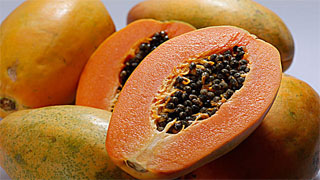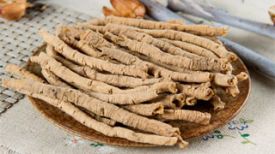
1. Aliases
Light skinned papaya, Tie Jiao pear, Autumn papaya, Papaya fruit, Sour papaya.
2. Plant morphology
Small trees or shrubs. It can reach a height of up to 10 meters, with cylindrical branches and no thorns. Single leaf alternate, leaf blade leathery, elliptically ovate or elongated elliptical; Petioles sparsely pilose with glandular structures; The stipules are membranous, ovate lanceolate, with glandular edges. Flowers solitary in leaf axils; Calyx bell shaped, sepals 5, triangular lanceolate, with glandular teeth at the edges, densely covered with light brown hairs on the inner surface, reflexed; 5 petals, obovate, light pink, with many stamens, less than half the length of the petals; Style 3-5, base connate, stigma head shaped, equal to or slightly longer than stamens. The fruit is oval shaped, 10-15 centimeters long, dark yellow, and woody. The flowering period is in April, and the fruiting period is from September to October.
3. Origin distribution
Common cultivation in various regions. Distributed in Sichuan, Guizhou, Guangxi, Guangdong and other places.
4. Harvesting and processing
Harvest the fruits in summer and autumn when they are green and yellow. Divide the fruits vertically into 2-4 petals and sun dry the inner surface upwards or in boiling water. Remove and sun dry the fruits.
5. Characteristics of medicinal herbs
Papaya fruit is oval or oval in shape, often divided into 2-4 petals, measuring 4-9 centimeters in length and 3.5-4.5 centimeters in width. The outer surface is reddish brown or brownish brown, smooth without wrinkles, or slightly rough; The cross-section of the fruit flesh is rough and appears granular. The seeds are mostly dense, with 40-50 seeds per ovary, usually mostly falling off. The seeds are flat and triangular in shape, with a slight odor and a slightly sour taste, giving it a grainy texture when chewed. It is better to have a solid texture and a sour taste.
6. Nature, taste, and meridian tropism
Warm in nature and sour in taste. Guigan Meridian and Spleen Meridian.
7. Effect and function
Soothing the liver and tendons, harmonizing the stomach and transforming dampness. Belonging to the subcategory of dispelling wind and dampness, it is a strong muscle and bone medicine for dispelling wind and dampness.
8. Clinical applications
Dosage 6-9 grams, decoction for oral use, used to treat dampness, numbness, swelling and pain in the waist and knee joints, vomiting and diarrhea, and athlete's foot edema. Treat acute bacterial dysentery with 5 papaya slices per time, 3 times per day. Papaya granules for treating acute viral hepatitis; Papaya gum can replace plasma to treat hemorrhagic shock, as well as rheumatoid arthritis, athlete's foot, and other conditions.
9. Pharmacological research
Papaya has hepatoprotective, antibacterial, and tumor inhibiting effects and effects. Papaya granules have a protective effect on acute liver damage in rats caused by carbon tetrachloride. In vitro experiments have varying degrees of inhibitory effects on various intestinal bacteria, Staphylococcus aureus, and other bacteria. The water extract has a significant inhibitory effect on Ehrlich ascites carcinoma in mice, and its effective anti-cancer component is organic acids.
10. Chemical composition
Papaya contains malic acid, tartaric acid, citric acid, ascorbic acid, fumaric acid, and saponins; It also contains potassium malate and oleanolic acid, chlorogenic acid ethyl ester, caffeic acid, chlorogenic acid, aconitic acid, flavonoids, and tannins.
11. Taboos for use
Lower waist and knees are weak. It is not suitable for those with deficiency of essence and blood, insufficient true yin, and excessive dampness and heat. Those with urinary incontinence should take it with caution.
12. Compatibility prescription
① Treating dampness and heat in feet: 15 grams each of papaya and coix seed, 9 grams each of Atractylodes macrocephala and Poria cocos, and 6 grams each of Huangbai. Boiled in water. (Qingdao Chinese Herbal Medicine Handbook)
② Treat navel colic: one or two pieces of papaya, seven pieces of mulberry leaves, and three pieces of jujube (crushed). Two liters of water. Boil half a liter and take it orally. (Meng Xi Fang)
③ Treating rheumatism and numbness: Take a small cup of papaya soaked in wine twice a day. (Tianjin Chinese Herbal Medicine)
④ More than just treating diarrhea: 60g of rice and beans, 30g of papaya, ginger, and licorice each. For fine powder, take 6 grams per serving. Mix rice and drink at different times. ("Chicken Peak Puji Formula" Papaya Soup)
The content of the article is for clinical reference only. Non professionals in traditional Chinese medicine are not allowed to try medication.


